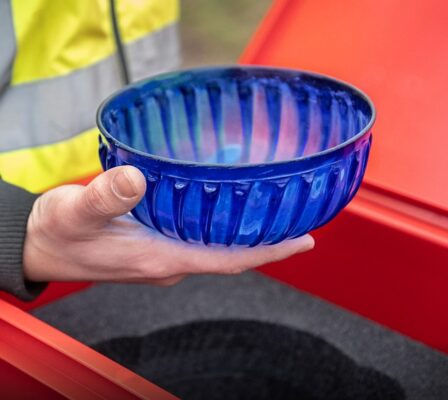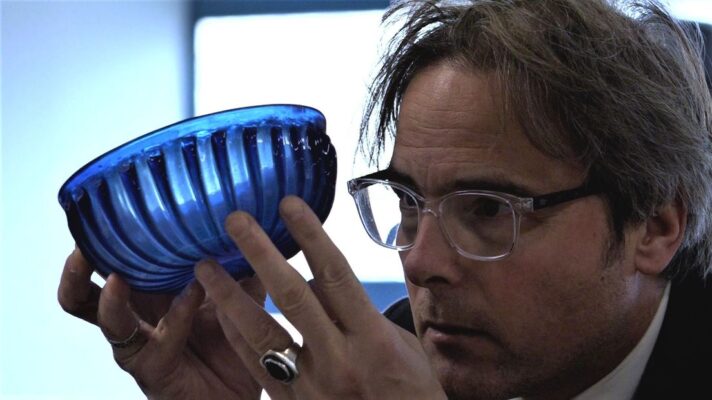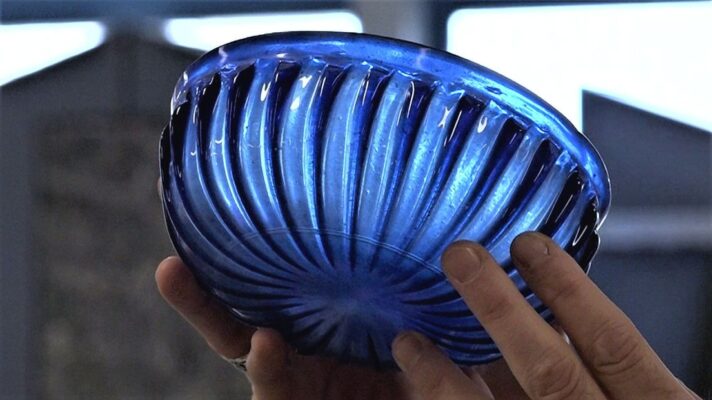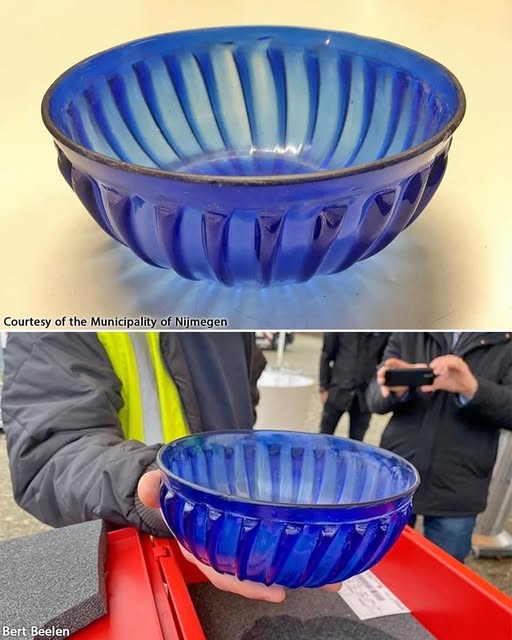In 2022, archaeologists in Nijmegen, a city in the Netherlands, made an extraordinary discovery: a 2,000-year-old Roman glass bowl, perfectly intact. This rare find offers valuable insights into ancient craftsmanship and materials, shedding light on the cultural exchanges and technologies of the Roman Empire. Follow archeology.dulichvn.net to learn more about mysterious artifacts.

Discovery of the Blue Glass Bowl
A Remarkable Archaeological Discovery
The blue glass bowl was uncovered during a highly anticipated archaeological excavation in Nijmegen, a city with deep ties to Roman history. Nijmegen, one of the oldest cities in the Netherlands, was a key Roman settlement, serving as a military and trade hub. This discovery is particularly striking because the bowl, which is about the size of a palm, remained perfectly intact after being buried for over 2,000 years. Given that many ancient glass artifacts typically degrade over time, the exceptional preservation of this item took archaeologists by surprise, making it a rare and invaluable find.
Impressive Preservation and Craftsmanship
What sets this Roman glass bowl apart is its extraordinary preservation. Unlike many ancient artifacts that succumb to the ravages of time, this bowl has remained in remarkably good condition. Its brilliant blue color and the intricate vertical stripe pattern etched into the surface are still clearly visible, demonstrating the high level of craftsmanship that went into its creation. The bowl’s survival without significant wear is a testament to the skill and ingenuity of Roman glassmakers, as well as the favorable conditions that allowed the object to endure for millennia beneath the earth.
The Significance of Nijmegen as the Find’s Location
The bowl was discovered in Nijmegen, a city with a rich Roman heritage, making it an ideal location for such an important find. Known in Roman times as Noviomagus, the city was a central military base and a key trading post along the Roman frontier. Excavations in this area have yielded numerous other artifacts, offering invaluable insights into daily life in Roman times. This particular discovery contributes to our understanding of the widespread reach and advanced technology of the Roman Empire, as well as the cultural and artistic practices that thrived in this once-vibrant city.

Characteristics of the Roman Glass Bowl
A Distinctive Vertical Stripe Pattern
One of the most remarkable features of this Roman bowl is its intricate pattern of vertical stripes. These stripes were skillfully drawn into the glass while it was still in a molten state, showcasing the advanced techniques used by Roman glassmakers. The pattern not only adds to the aesthetic appeal of the bowl but also reflects the mastery and precision that went into creating such objects. The bowl’s design is a testament to the Romans’ ability to blend functionality with beauty, producing items that were both practical and artistically sophisticated.
The Blue Color: A Testament to Roman Innovation
The striking blue color of the bowl is another exceptional feature, caused by the inclusion of metal oxide in the glass mixture. This substance was carefully added during the crafting process, resulting in the vibrant hue that remains intact after centuries. The use of metal oxide represents a significant achievement in ancient glassmaking, as it allowed Roman artisans to create a broader spectrum of colors in their glassware. The bowl’s rich blue shade is a symbol of Roman craftsmanship and the innovative spirit that characterized their work with glass.
The Size and Potential Uses of the Bowl
Measuring about the size of a palm, the bowl is compact yet elegant, suggesting it may have served personal or ceremonial functions. Its small size indicates it could have been used for holding small offerings, food, or liquids in religious or private contexts. Given its pristine condition, it is likely that the bowl was highly valued by its owner, possibly kept as a treasured artifact or passed down through generations. The careful preservation of this item adds to its intrigue, offering a glimpse into the lifestyle and customs of the Roman elite.

See more: The Restoration of a 1941 Horch 853 Sportcabriolet: A Timeless Classic
The Significance of the Discovery
Insights into Roman Glassmaking Techniques
This extraordinary find offers a rare glimpse into the advanced glassmaking techniques practiced by the Romans over two millennia ago. The bowl’s intricate design, including the precise vertical stripes and the vibrant blue hue, highlights the sophistication of Roman artisans. These craftsmen were able to transform molten glass into objects that were both practical and artistically impressive. The use of metal oxides to achieve vibrant colors was a particularly advanced technique, showcasing their ability to manipulate materials and create visually striking items. This discovery adds a new layer to our understanding of Roman craftsmanship and their mastery over glass as both a functional and decorative medium.
Cultural and Trade Connections of the Roman Empire
The presence of this finely crafted bowl also sheds light on the vast trade networks that spanned the Roman Empire. The high-quality glass used in its creation, along with its distinct design, suggests that raw materials and specialized crafting techniques were shared and exchanged across various regions of the empire. This bowl could very well have been made from glass imported from far-off provinces or made by artisans who had access to advanced technologies shared through trade routes. The spread of Roman glassmaking expertise throughout the empire not only influenced artistic styles but also allowed for the circulation of materials and techniques that connected distant corners of the ancient world.
A Valuable Contribution to Archaeological Knowledge
The discovery of this remarkably preserved Roman bowl adds immeasurable value to the collection of artifacts found in the Netherlands, significantly enhancing our understanding of Roman daily life. Items such as this offer crucial insights into the materials and craftsmanship used for everyday objects, providing a snapshot of Roman domestic life, artistic preferences, and technological innovations. As one of the few intact Roman glass artifacts uncovered, this bowl stands as a testament to the high level of sophistication achieved by Roman society. Its preservation allows historians and archaeologists to gain a deeper understanding of how the Romans lived, traded, and created, offering a direct link to the past that enriches our cultural heritage.

Conclusion
The discovery of the 2,000-year-old Roman bowl in Nijmegen serves as a remarkable reminder of the ingenuity of Roman artisans. Its perfect preservation and intricate design offer a direct link to the ancient past, providing crucial insights into the culture, trade, and craftsmanship of the Roman Empire.


CÁC TIN KHÁC
Mary Walton: The Forgotten Inventor Who Helped Clean Up America’s Cities
Tomb of Queen Nefertari in the Valley of the Queens, Egypt
Discover the Hypostyle Hall of the Temple of Hathor at Dendera
Venus de Losange: Unveiling the Mystery of a 20,000-Year-Old Paleolithic Icon